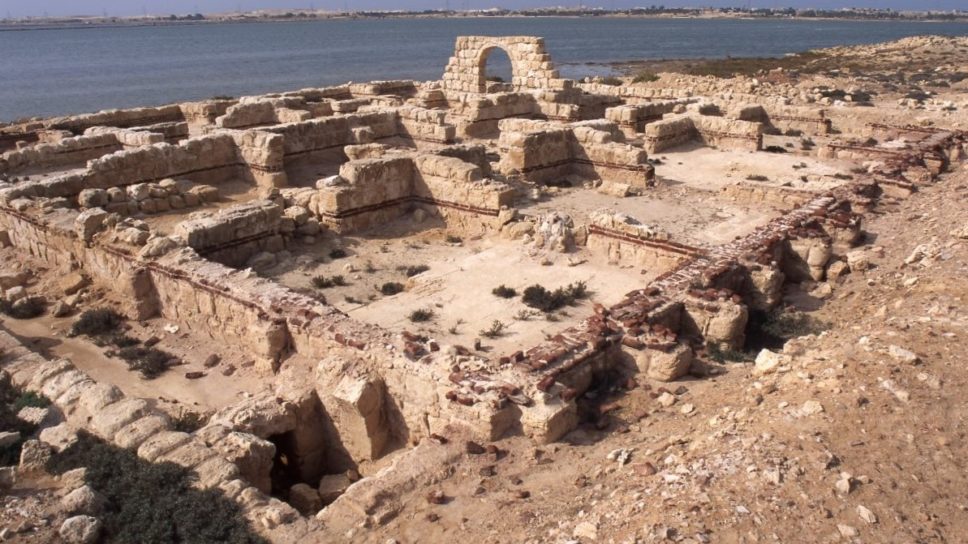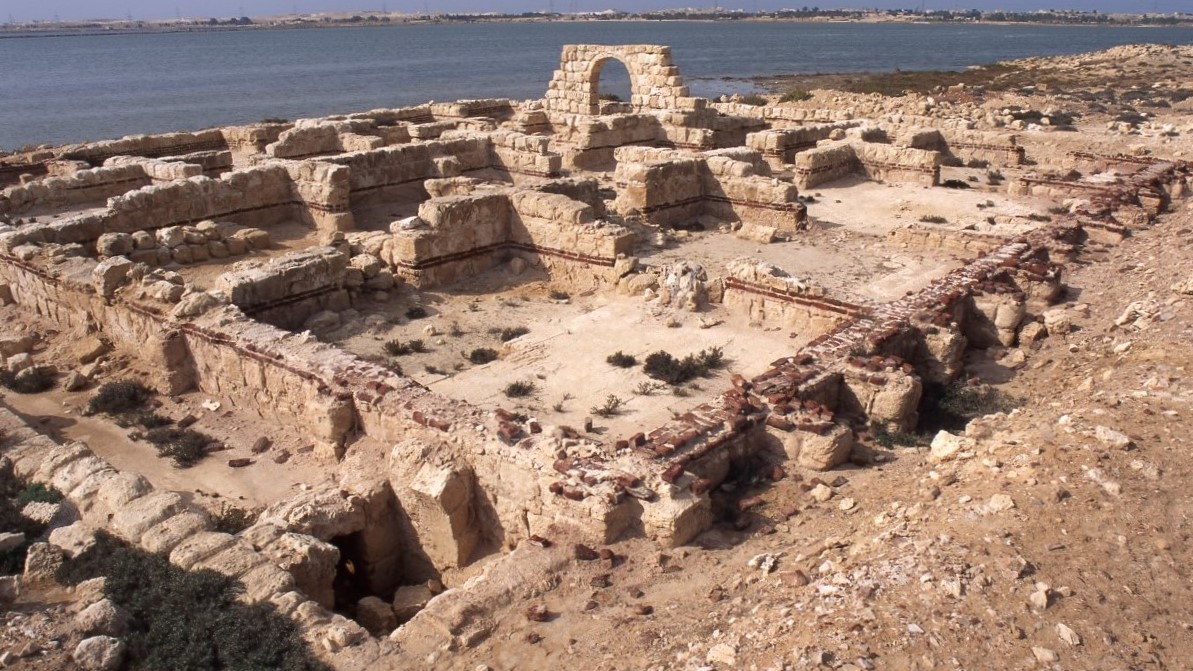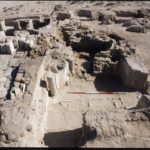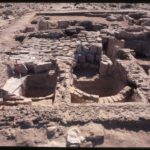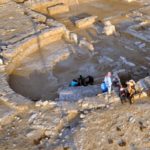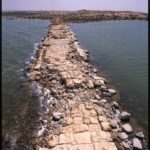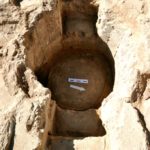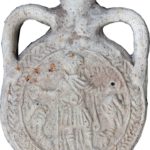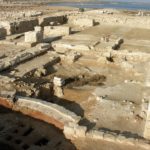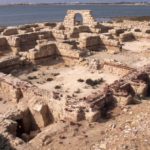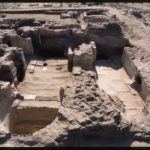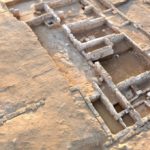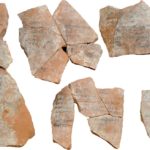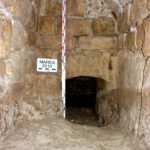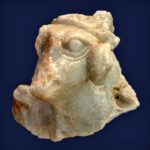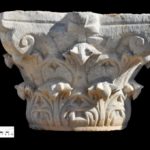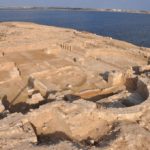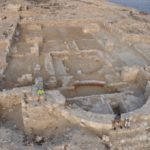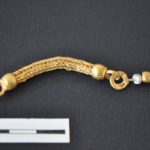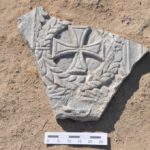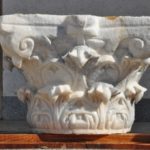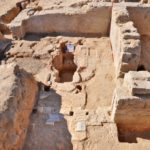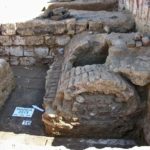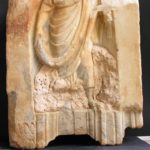Marea
-
Project name:
Marea Archaeological Project
Project logo:
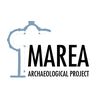
Project website:
Facebook:
Academia.edu:
-
Type of site:
Settlement: city, harbor
Location:
Egypt
Mareotis Region
On the shore of Lake Maryut, 45 km west of AlexandriaDating:
– Hellenistic period – a jetty built of stone blocks bonded with metal dovetail cramps (1st century BC)
– Roman period – pottery kiln in the apse of the basilica (1st–2nd century)
– Late antique-Byzantine period (5th–8th century)
Most interesting finds:
– funerary chapel from the 5th–6th century AD
– baths from the 6th century AD, with a water wheel drawing water from a well (so-called saqiyah)
– early Byzantine basilica dating to the 5th–8th century AD
– three jetties, the longest of which measures 125 m and is located near the basilica
– outbuildings behind the basilica
– one of the largest sets of ostraca discovered in Egypt – 180 pottery fragments with inscriptions
History of research:
Dates of PCMA mission’s work:
2000–
Type of research:
Excavations, conservation work
Directors:
Hanna Szymańska (2000–2010)
Krzysztof Babraj, Archaeological Museum of Kraków (2011–2019)
Tomasz Derda, Institute of Archaeology, University of Warsaw (since 2019)
Co-operating institutions:
– Polish Centre of Mediterranean Archaeology, University of Warsaw
– Archaeological Museum of Kraków
and
– Bronisław Markiewicz, State Higher School of Technology and Economics in Jarosław
– Tadeusz Kościuszko, University of Technology in Kraków
Description of the site and research:
Marea is an ancient city located to the south-west of Alexandria, on the shore of Lake Mareotis (Maryut). It is known from classical historical sources: Herodotus (II, 30,2), Diodorus Siculus (I, 68) and Thucydides (I, 104). In antiquity, Marea was an important harbor and trading center. It was famous for its excellent wine which was distributed throughout the Mediterranean Basin. The proposed identification of the site as Philoxenite, a city founded by a consul during the reign of the emperor Anastasius (491-518 AD), is still doubtful. It was suggested by Mieczysław Rodziewicz, who based his hypothesis on survey results and the location of the site.
Thanks to its location, the city was an important harbor in the Roman and Byzantine periods, but it had probably existed already in the Ptolemaic period. Since Lake Mareotis was connected with the Nile and the coast by a network of canals, products from Upper Egypt reached the harbor on its shore. Four long jetties built of stone ashlars bonded with waterproof mortar are evidence of the port’s significance. The longest of the jetties is 125 m long.
In 2003, research began in the Byzantine basilica in Marea, the second largest in Egypt. Objects discovered there date from the end of the 5th to the beginning of the 8th century, i.e., the heyday of the city. Under the apse and part of the presbytery, a huge pottery kiln from the Roman period was found. It is one of the largest kilns discovered in Egypt to date. The builders of the basilica used its fragments in the foundations of the apse.
A bath complex with a water wheel drawing water from a well (so-called saqiyah) was uncovered near the basilica. Further to the south stood a funerary chapel; both structures date to the 6th century. Behind the apse, there was a group of buildings identified as storerooms, shops, workshops, and houses. It yielded the largest known set of ostraca from the 5th–6th century, inscribed with notes regarding the building of the basilica.
Information about the research:
Season by season – “PCMA Newsletter”:
- 2018 season
- 2017 season
- 2016 season
- 2015 season
- 2014 season
- 2013 season
- 2012 season
- 2011 season
- 2010 season
- 2009 season
- 2008 season
- 2007 season
- 2006 season
Associated events:
2023-11 National Science Center grant OPUS 25 for PCMA UW project in Marea
2022-03 Conference: ‘Marea’ in Context
2020-09 On-line conference: „Marea” ad Aegyptum – new research (season 2019)
2018-01 PolAr lecture in Cairo: House H1 in Marea
2016-09 Lecture in the PCMA Research Centre in Cairo: A new archive from Late Antique Egypt
2016-01 Exhibition “Polish excavations in Marea, Egypt, 2000–2014” (Cairo)
2015-11 Exhibition “Polish excavations at Marea in Egypt, 2000–2014” (Alexandria)
See also the Project’s profile on Academia.edu
Derda, T., Gwiazda, M., Burdajewicz, J. (2023), A Private House in ‘Marea’/Philoxenite Transformed into a Monastic Institution and Other Christian Hybrid Buildings in the Mareotis Region. Journal of Coptic Studies. 25, 107-138. doi:10.2143/JCS.25.0.3292057
Gwiazda, M. (2023), The Pilgrim Town of Philoxenite and Settlement Continuation in the Early Islamic Hinterland of Alexandria, Egypt. Journal of Islamic Archaeology 10.1, 5-36 doi:https://doi.org/10.1558/jia.24820
Gwiazda, M. (2023), Modular designs at the Early Byzantine pilgrimage site of Philoxenite, Egypt. Journal of Roman Archaeology, 1-19 doi:10.1017/S1047759423000120
Gwiazda, M., Derda, T., Barański, T., (2022), From Roman industrial center to early Islamic town: archaeological excavations at ʻMarea’/Philoxenite in the 2020–2021 season. Polish Archaeology in the Mediterranean 31, 333-373 doi:10.31338/uw.2083-537X.pam31.08
Gwiazda, M., & Derda, T. (2021). Marea: A swan song of ancient urban planning. Antiquity, 1-8. doi:10.15184/aqy.2021.88
Derda, T., Gwiazda, M., Misiewicz, K., Małkowski, W. (2020). Marea/Northern Hawwariya in northern Egypt: Integrated results of non-invasive and excavation works, Archaeological Prospection 28(2), 123–136. DOI: 10.1002/arp.1801
Babraj, K., Drzymuchowska, A., Tarara, D. (2020). The 5th Century Great Transept Basilica in Marea (Egypt) and the 4th Century Predecessor Church Discovered in 2018, (in:) K. Myśliwiec, A. Ryś (eds.), Crossing Time and Space to Commemorate Hanna Szymańska, Warsaw, Wiesbaden, 11–34.
Derda, T. (2020). ‘Marea’ ad Aegyptum: New Research and New Documents, in: K. Myśliwiec, A. Ryś (eds.), Crossing Time and Space to Commemorate Hanna Szymańska, Warsaw, Wiesbaden, 61–74.
Derda, T., Gwiazda, M., Pawlikowska-Gwiazda, A. (2020). Development of a Settlement on the Northeastern Promontory at ‘Marea’, Polish Archaeology in the Mediterranean 29.2, 529–550. DOI: 10.31338/uw.2083-537X.pam29.2.23
Derda, T., Gwiazda, M., Pawlikowska-Gwiazda, A., Wieczorek, D.F. (2020). Excavations in the Northern and Eastern parts of the Byzantine Town at Marea, Polish Archaeology in the Mediterranean 29.2, 551–576. DOI: 10.31338/uw.2083-537X.pam29.2.24
Jastrzębowska, E. (2020). Capitals on the Move: from Late Antiquity to 18th century Poland, in: K. Myśliwiec, A. Ryś (eds.), Crossing Time and Space to Commemorate Hanna Szymańska, Warsaw, Wiesbaden, 83–96.
Lichocka, B. (2020). Un rouleau de folles découvert à Marea (Égypte), (in:) K. Myśliwiec, A. Ryś (eds.), Crossing Time and Space to Commemorate Hanna Szymańska, Warsaw, Wiesbaden, 147–158.
Derda, T, Gwiazda, M, Misiewicz, K, Małkowski, W. (2020). Marea/Northern Hawwariya in northern Egypt: Integrated results of non‐invasive and excavation works. Archaeological Prospection, 1– 14. https://doi.org/10.1002/arp.1801
Gwiazda, M. & Pawlikowska-Gwiazda, A. (2019). Excavations next to House H1 in ‘Marea’ (Egypt) in 2017. Polish Archaeology in the Mediterranean, 28/2, 61–79. DOI: 10.31338/uw.2083-537X.pam28.2.04
Gwiazda, M., & Wielgosz-Rondolino, D. (2019). ‘Marea’ on Lake Mareotis: A Roman Amphorae Dump, a Byzantine Period House, and Its Early Islamic Dwellers. The Journal of Egyptian Archaeology, 105(2), 259–273. https://doi.org/10.1177/0307513320905850
Babraj, K., (2018). Wielka bazylika transeptowa w “Marei” w Egipcie z V w. i jej poprzednik nowo odkryty kościół z IV w. w 2018 r. / The 5th-century Great Transept Basilica in “Marea”, Egypt, and the 4th-century predecessor church discovered in 2018, Materiały Archeologiczne 42, 203–224.
Kucharczyk, R., (2018). Glass finds from the basilica in Marea, 2018, Materiały Archeologiczne 42, 225–233.
Babraj, K., Drzymuchowska, A. (2017). Highlights from the Polish Excavations at Marea/Philoxenite 2000–14, in: Christianity and Monasticism in Northern Egypt: Beni Suef, Giza, Cairo, and the Nile Delta, 281–296.
Wielgosz-Rondolino, D., Gwiazda, M. (2016). Marea season 2014: excavation in House H1, Polish Archaeology in the Mediterranean 25, 115–126.
Babraj, K., Kogut, J. (2015). Late-Roman and early-Bizantyne analogues of structures in Marea/Philoxenite, Materiały Archeologiczne XL, 87–100.
Wielgosz-Rondolino, D., Gwiazda, M. (2015). A Late Antique House in Marea, Egypt. Excavation season 2014, Światowit 12(53)/A, 255–261.
Babraj, K., Drzymuchowska, A., and Willburger, N. (2014). Marea 2011. Polish Archaeology in the Mediterranean 23/1, 45–62.
Babraj, K. Szymańska, H. (2013). Badania bazyliki i mol w Marei w Egipcie / Research on the Basilica and piers at Marea in Egypt, Materiały Archeologiczne 39, 169–194.
Babraj, K. et al. (2013). Eleventh season of excavations at Marea (2010) with appendix: The harbor jetties of Marea. Polish Archaeology in the Mediterranean 22, 55–78.
Kogut, J. (2013). Numerical modeling of response and analysis of the ancient pottery kiln from Marea (Egypt), Materiały Archeologiczne XXXIX, Krakow, 55–58.
Drzymuchowska, A. (2012). Marea 2009: Pottery from the excavations. Polish Archaeology in the Mediterranean 21, 72–77.
Babraj, K., Kogut, J., and Zięba, K. (2012). Numerical modeling of response and analysis of the ancient pottery kiln from Marea (Egypt) due to the soil loading, AGH Journal of Mining and Geoengineering 36/1, Kraków, 203–209.
Szymańska, H., Babraj, K. (2012). Marea. Report 2009. Polish Archaeology in the Mediterranean 21, 59–71.
Wipszycka, E. (2012). Marea and Philoxenite. Where to locate them’, Études et Travaux 25, 418–432.
Woronko, B. (2012). Late-Holocene Dust Accumulation within the Ancient Town of Marea (Costal Zone of the South Mediterranean Sea, N Egypt), Quaternary International 266, 4–13.
Drzymuchowska, A. (2011). Marea 2008: Pottery from the excavations. Polish Archaeology in the Mediterranean 20, 97–101.
Szymańska, H., Babraj, K. (2011). Marea: excavations 2008. Polish Archaeology in the Mediterranean 20, 81–96.
Szymańska, H., Babraj, K. (2010). Marea 2007. Eight season of excavations. Polish Archaeology in the Mediterranean 19, 71–76.
Wronska-Kucy, B. (2010). Conservation work at Marea in 2007. Polish Archaeology in the Mediterranean 19, 77–80.
Szymańska, H. (2010). Report on the Activities of the Polish Archaeological Mission at Marea in 2007, Annales du Service des Antiquité de l’Égypte 84, 401–409.
Szymańska, H., Babraj, K. (2010). Architectural decor of the basilica in Marea (Egypt). Preliminary report, in: J. Kościuk (ed.) non Solum Villae. Księga pamiątkowa ofiarowana profesorowi Stanisławowi Medekszy, Wrocław: Oficyna Wydawnicza Politechniki Wrocławskiej, 302–315.
Szymańska, H., Babraj, K. (2010). Marea or Philoxenite? Polish Excavations in the Mareotic Region 2000–2007, in: L. Blue (ed.), Lake Mareotis: Reconstructing the Past (= BAR Int. Ser. 2113), Oxford, 75–85.
Szymańska, H., Babraj, K. (2009). Polish Excavations in the Basilica at Marea (Egypt) in 2007 and 2008, Bulletin de la Société d’Archéologie Copte 48, 77–84.
Szymańska, H., Babraj, K. (2008). Marea: Report on the excavations of the Polish Archaeological Mission in 2006. Polish Archaeology in the Mediterranean 18, 51–61.
Szymańska, H., Babraj, K. (2008). Rozwój starożytnego miasta Marea w Egipcie na tle warunków środowiska, Zeszyty Naukowe Szkoły Wyższej Przymierza Rodzin w Warszawie, Seria Geograficzno-Turystyczna 1, 7–25.
Szymańska, H., Babraj, K. (2008). Byzantine Marea Excavations in 2000–2003 and 2006. Marea 1, (=Biblioteka Muzeum Archeologicznego w Krakowie IV), Kraków.
Wronska-Kucy, B. (2008). Conservation work at Marea in 2006. Polish Archaeology in the Mediterranean 18, 62–67.
Kucharczyk, R. (2006). Late Roman/Early Byzantine glass from the basilica in Marea, 2004. Polish Archaeology in the Mediterranean 17, 70–74.
Szymańska, H., Babraj, K. (2006). Polish Excavations in the Basilica at Marea, Bulletin de la Société d’Archéologie Copte 45, 107–117.
Szymańska, H., Babraj, K. (2006). Marea: sixth season of excavations. Polish Archaeology in the Mediterranean 17, 55–66.
Wronska-Kucy, B. (2006). Marea 2005: Masonry conservation report. Polish Archaeology in the Mediterranean 17, 67–69.
Kucharczyk, R. (2005). Glass finds from the basilica in Marea, 2004. Polish Archaeology in the Mediterranean 16, 55–59.
Szymańska, H., Babraj, K. (2005). Fouilles Archéologiques de Marea en Egypte saison 2002–2003, Archeologia 55, 2004, 126–129.
Szymańska, H., Babraj, K. (2005). Marea: Excavations 2004. Polish Archaeology in the Mediterranean 16, 43–54.
Kucharczyk, R. (2004). The glass finds from the basilica in Marea, 2003. Polish Archaeology in the Mediterranean 15, 63–66.
Szymańska, H., Babraj, K. (2004), The Ancient Port of Marea, Egypt, Minerva 15/3, 26–28.
Szymańska, H., Babraj, K. (2004). Körperpflege mit allem Konfort. Die Ruine eines Bades am Maryut-See in Ägypten sprechen für einen hohen technischen Standard in byzantinischer Zeit, Antike Welt, 35/6, 21–28.
Szymańska, H., Babraj, K. (2004). Marea: Fourth season of excavations. Polish Archaeology in the Mediterranean 15, 53–62.
Szymańska, H., Babraj, K. (2003). Marea: Season 2002. Polish Archaeology in the Mediterranean 14, 39–48.
Szymańska, H., Babraj, K. (2003). Fouilles Archéologiques de Marea en Egypte saison 2000–2001, Archeologia 53, 2002, 137–144.
Szymańska, H. and Babraj, K. (2003). Wstępny raport z wykopalisk w Marei w Egipcie. Sierpień–wrzesień 2002, Materiały Archeologiczne XXXIV, Kraków, 159–164.
Majcherek, G. (2002). Marea 2001: Note on the pottery. Polish Archaeology in the Mediterranean 13, 60–64.
Kucharczyk, R. (2002). Marea 2001: Windowpanes and other glass finds. Polish Archaeology in the Mediterranean 13, 65–71.
Szymańska, H., Babraj, K. (2002). Marea: Second interim report, 2001. Polish Archaeology in the Mediterranean 13, 45–53.
Szymańska, H., Babraj, K. (2001). Marea: First interim report, 2000. Polish Archaeology in the Mediterranean 12, 35–45.
Szymańska, H., Babraj, K. (2001). Marea am Maryut-See, die erste Grabungssaison, Herbst 2000, Kemet 10/3, 65–69.
Gallery:
-
1. Excavations in the baths / Wykopaliska w łaźni (fot. T. Kalarus)
-
2. Excavations in the baths / Wykopaliska w łaźni (fot. T. Kalarus)
-
3. Part of the basilica with the apse / Fragment bazyliki z apsydą (fot. T. Skrzypiec)
-
4. The longest jetty (no. 3), 125 m long, located near the basilica / Najdłuższe molo nr 3 przy bazylice, długości 125 m (fot. T. Kalarus)
-
5. Baptistery of the basilica; negatives of marble slabs visible / Baptysterium w bazylice, widoczne negatywy po marmurowych płytach (fot. T. Skrzypiec)
-
6. St Menas flask, 5th–6th century / Ampułka św. Menasa, V–VI w. (fot. T. Kalarus)
-
7. View of the nave of the basilica / Widok na nawę główną w bazylice (fot. T. Skrzypiec)
-
8. Storerooms discovered in 1978 by Prof. Fakharani from the Alexandria University / Magazyny odkryte w 1978 r. przez prof. Fakharaniego z Uniwersytetu Aleksandryjskiego (fot. T. Kalarus)
-
9. Bath pools / Baseny w łaźni (fot. T. Kalarus)
-
10. Buildings behind the apse of the basilica / Zabudowania za apsydą bazyliki (fot. T. Skrzypiec)
-
11. Fragments of ostraca with notes regarding the preliminary stage of the construction of the basilica, 5th–6th century / Fragmenty ostrakonów z zapisami dotyczącymi wstępnej fazy budowy bazyliki, V–VI w. (fot. T. Skrzypiec)
-
12. Cistern underneath the northern part of the basilica / Cysterna pod pomieszczeniami w północnej część bazyliki (fot. T. Skrzypiec)
-
13. Fragment of a sculpture depicting a small ox / Fragment rzeźby przedstawiającej wołka (fot. T Skrzypiec)
-
14. Corinthian capital / Kapitel koryncki (fot. T. Skrzypiec)
-
15. Basilica / Bazylika (fot. T. Skrzypiec)
-
16. Basilica / Bazylika (fot. T. Skrzypiec)
-
17. Fragment of a gold earring with two pearls, 6th century / Fragment złotego kolczyka zakończonego dwiema perełkami, VI w. (fot. T. Skrzypiec)
-
18. Fragment of a chancel altar rail / Fragment balustrady ołtarza cancelli (fot. T. Skrzypiec)
-
19. Corinthian capital / Kapitel koryncki (fot. T. Skrzypiec)
-
20. Baptistery in the basilica / Baptysterium w bazylice (fot. T. Skrzypiec)
-
21. Brick structure under the floor of the basilica / Konstrukcja ceglana pod posadzką w bazylice (fot. T. Skrzypiec)
-
22. Roman stele / Stela rzymska (fot. A. Drzymuchowska)

